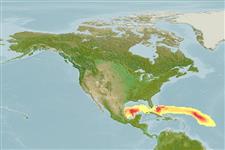Classification / Names
Κοινά ονόματα | Συνώνυμα | Catalog of Fishes(Γένος, Είδη) | ITIS | CoL | WoRMS | Cloffa
>
Scombriformes (Mackerels) >
Caristiidae (Manefishes)
Etymology: Platyberyx: Name from the Greek 'platy' meaning flat and Beryx, a genus of beryciform fishes; pietschi: Named for Dr. Theodore W. Pietsch.
Eponymy: Dr Theodore ‘Ted’ Wells Pietsch III (d: 1945) was a professor of ichthyology at the University of Washington, Seattle (1978 onwards) and is an American systematist and evolutionary biologist especially known for his studies of anglerfishes. [...] (Ref. 128868), visit book page.
Environment: milieu / climate zone / depth range / distribution range
Οικολογία
Θαλασσινό(ά) βαθυπελαγικό(ς); εύρος βάθους 1 - 750 m (Ref. 94277). Tropical
Central Pacific, Southwestern Pacific and Northwestern Atlantic.
Μέγεθος / Βάρος / Age
Maturity: Lm ? range ? - ? cm
Max length : 9.3 cm SL αρσενικό/απροσδιόριστο; (Ref. 94277)
Short description
Κλείδες προσδιορισμού | Μορφολογία | Μορφομετρία
Μαλακές ραχιαίες ακτίνες (συνολικά) : 30 - 31; Μαλακές εδρικές ακτίνες: 18 - 19; Σπόνδυλοι: 33 - 35. This species is distinguished from its congeners by having an anteriorly directed hook-like process on the third posteriormost ventral procurrent caudal ray; differs from P. paucus by having greater number of dorsal-fin rays (30-31 vs. 24-26), anal-fin rays (18-19 vs. 15-16), pectoral-fin rays (17-18 vs. 16-17), and vertebrae (33-35 vs. 31); differs from P. andriashevi by having fewer dorsal-fin rays (30-31 vs. 31-37), anal-fin rays (18-19 vs. 19-22), and vertebrae (33-35 vs. 36-39); differs further from P. opalescens by having small bristles and larger spikes on the gill rakers (vs. small bristles only), and from P. rhyton and P. mauli by the greater prepectoral (>39% SL vs. <36% SL) and prepelvic (>36% SL vs. <33% SL) length, shorter dorsal-fin base (<70% SL vs. >75% SL), and smaller mouth (upper jaw extending to midorbit vs. posterior margin of orbit) (Ref. 94277).
Life cycle and mating behavior
Γεννητική Ωρίμανση | Αναπαραγωγή | Γεννοβολία | Αβγά | Γονιμότητα | Προνύμφες
Stevenson, D.E. and C.P. Kenaley, 2013. Revision of the manefish genera Caristius and Platyberyx (Teleostei: Percomorpha: Caristiidae), with description of five new species. Copeia 2013(3):415-434. (Ref. 94277)
IUCN Red List Status (Ref. 130435: Version 2024-1)
Threat to humans
Harmless
Human uses
Εργαλεία
Special reports
Download XML
Διαδικτυακές πηγές
Estimates based on models
Preferred temperature (Ref.
123201): 13.2 - 23.6, mean 19 °C (based on 13 cells).
Phylogenetic diversity index (Ref.
82804): PD
50 = 0.5156 [Uniqueness, from 0.5 = low to 2.0 = high].
Bayesian length-weight: a=0.02455 (0.00947 - 0.06362), b=3.00 (2.78 - 3.22), in cm total length, based on LWR estimates for this (Sub)family-body shape (Ref.
93245).
Τροφικό Επίπεδο (Ref.
69278): 3.4 ±0.5 se; based on size and trophs of closest relatives
Fishing Vulnerability (Ref.
59153): Low vulnerability (10 of 100).
